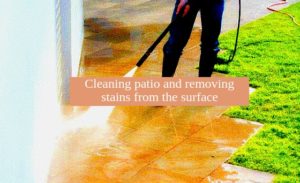 Concrete patios are durable, inexpensive, and low-maintenance. However, food, debris, and the elements may leave marks, stains, and grime buildup on their surface.
Concrete patios are durable, inexpensive, and low-maintenance. However, food, debris, and the elements may leave marks, stains, and grime buildup on their surface.
Regular foot traffic can cause dirt, mud, grime, and grease to build up. This can leave your walking path, cement deck, or concrete patio looking dull and dirty.
In order to keep it looking neat and nice, you should regularly clean your garden and patio area. You can do this with or without a pressure washer. Best tackle this job during the spring cleaning of your place. Keep reading to find out how to tackle this job in a quick and easy way, making the best out of it.
Step 1 Remove loose dirt and debris
Remove your outdoor furniture, barbeque, or plant pots. make sure the whole surface of the patio is free of items and that you will be able to properly clean it. Sweep away loose dirt and leaves. If your furniture is too large to move, use a plastic sheet to cover it. That way you will protect it from damage while cleaning.
Step 2 Treat patio stains
For water, mould, and mildew stains: Use a pressure washer or your garden hose to remove any debris or dirt that may be stuck to your patio’s surface. If plain water doesn’t do the trick, use a solution of ¾ cup of bleach and 4 litres of water. Wearing protective gear, including rubber gloves, scrub the area with a brush. Scrub until the stains are gone then thoroughly rinse with warm water. Let the area air dry before putting your things back on it. Make sure it is completely dry before placing back your furniture there. Trapped moisture may cause mould and mildew to grow on the patio or furniture.
For grease and oil stains: Sprinkle sawdust, cornstarch, or baking soda on the stain. That way you will absorb most of the oil causing it. You can also mix baking soda and water to create a cleaning paste. Scrub it gently all over the stain and let it sit for 30-60 minutes. Then wash the solution or sweep away any loose powder that might be left on the surface of your patio.
For rust stains: White vinegar is a practical, inexpensive and eco-friendly way to get rid of rust stains from your concrete patio. Spray it on the stained area, then let it sit for 30-40 minutes. Scrub with a stiff-bristled brush. Repeat the process if needed.
Step 3 Clean patio floors
Dish soap and water: Dish soap contains degreasing agents so it is perfect for removing greasy or oily stains from your patio floor. To make a cleaning solution, add a few drops of dish soap to 4 litres of water, and mop the whole surface of your concrete patio floor. If there are any stubborn stains, you may need to scrub them a bit harder. Let this soapy solution sit on the patio for a while, then wipe it with clean water and allow it to air dry completely.
Vinegar: These natural ingredients are perfect for cleaning rust stains or charcoal residue. Mix equal parts vinegar and water, and spray the stained area of the patio. Scrub it until the stains are gone, then give it a good rinse. Make sure you protect your eyes and skin.
Oxygen bleach: Wear rubber gloves and use a cup to sprinkle the solution all over the patio. Scrub with a push broom or a soft-bristled brush. Let it sit for 10-15 minutes, then rinse it off with clear water from the hose. Never mix bleach with other cleaning agents.
Pressure washer: If you do not own a pressure washer, you can rent one from your local hardware store. If you are unsure of what pressure settings to use, test in an inconspicuous area to make sure no damage will occur.
To prevent stains and dirt from accumulating so fast:
You can purchase a concrete sealer. If you choose to do that, use a paintbrush or a roller to apply all over the surface of your patio. You can do this twice a year, once in spring, and once before the winter months.
You only need to clean your patio once a year. You can tackle this task with your annual spring cleaning. That way you will prevent dirt and stains from accumulating, as well as avoid grime buildup. While you are at it, check if your patio or outdoor furniture need repairing.
When choosing a cleaning solution, always test on a small area to make sure no damage, etching, or discolouration occurs. Once you see which method works best for you, implement it in your regular cleaning schedule. Stick to this method and do not skip the patio cleaning. Once you start taking care of it on a regular basis, you will see drastic improvements in the overall look of your outdoor area.
